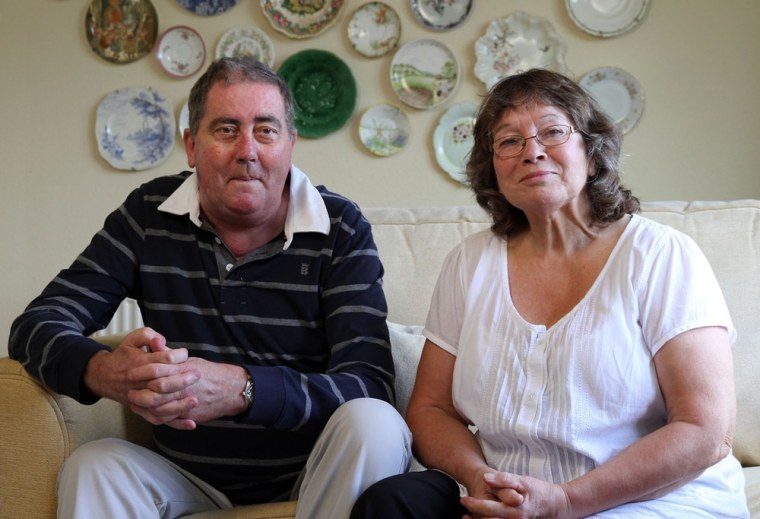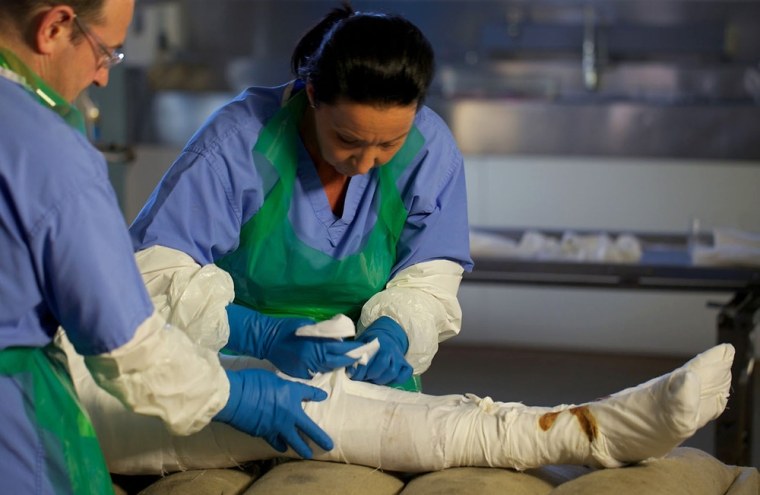Researchers have turned a former British taxi driver into an Egyptian-style mummy, with television cameras tracking every step in the process.
The results will be on view next Monday in "Mummifying Alan: Egypt's Last Secret," a documentary airing on Britain's Channel 4 television.
The show's producers chronicled the months-long procedure of preserving the body of Alan Billis, a 61-year-old retired taxi driver from Torquay in Devon, applying the techniques that the ancient Egyptians used on Tutankhamun.
Billis, who earned the nickname "Tutan-Alan," was terminally ill with cancer when he volunteered to undergo the procedure. He had the backing of his wife Jan, who said: "I'm the only woman in the country who's got a mummy for a husband."
The main scientist behind the experiment is Stephen Buckley, a chemist and research fellow at Britain's York University. For years, Buckley has been studying the preservation techniques that the Egyptians used during the 18th Dynasty. Alongside archaeologist Jo Fletcher, Buckley analyzed tissue samples from mummified bodies and finally put his findings to the test on Billis' body at Sheffield's Medico-Legal Center.
"I've come up with fantastic new insights that tell us a very great deal," Buckley said in a Channel 4 news release. "What I was able to do was to look at things in quite a different way, and in doing so get information that perhaps people had missed. It's turned current understanding, including my own, completely on its head."
The modern-day mummification isn't completely unprecedented: In 1994, Egyptologist Bob Brier and Ronald Wade, director of the Maryland State Anatomy Board, mummified a medical cadaver using ancient Egyptian techniques. But Buckley wanted to study the effects of a particular recipe thought to have been used on the "best of the best" mummies — and so he put out the call for a donor.
Alan Billis had been diagnosed with terminal lung cancer when he read a newspaper article about the experiment. In a video clip recorded before his death, Billis said he was instantly intrigued, and he called up the project's leaders to volunteer.

"If it doesn't work, it's not the end of the world, is it?" he told the documentary team. "Don't make any difference to me, I'm not going to feel it. It's still bloody interesting."
He said his main regret was that he would never know how the experiment turned out: "Shame I'm not gonna be around to see it, isn't it? I'd like to have seen that, because I like documentaries."
During his studies, Buckley used a gas chromatograph mass spectrometer and other instruments to identify the materials that were used by the priests in Tutankhamun's day, including beeswax, oils and resins. He went on to conduct a series of experiments using more than 200 pigs' legs as a substitute for human flesh. Buckley even rigged up a research shed where he could re-create the desert conditions present in ancient Egypt.
When Billis died in January, a medical team removed most of his organs — including his lungs and intestines — through a 4-inch incision on the left side of his body. The cavity was then sterilized and padded with linen.
Buckley went against the traditional wisdom that the Egyptians removed the brain of the deceased through the nose. He acknowledged that the procedure was often used, but noted that around half of the 18th Dynasty royal mummies retained their brains. In some cases, the shrunken remnants of the brain can still be seen in skull X-rays.
After the removal of the organs, the body's moisture content was removed using a caustic salt from the region, called natron, which was described by Greek historian Herodotus in 450 B.C. — 800 years after the 18th Dynasty. The scientists immersed the corpse in a salt bath for more than a month to draw out the water. To protect the skin from the harsh salt, it was covered in a layer of oils.
The body was then wrapped in linen, protecting it from light and insects. His wife made a visit to the scene, leaving favorite photographs and drawings by his grandchildren.
After three months of drying, the process was judged to be complete.
"The skin itself has this leathery appearance which indicates that he has become mummified all over," said forensic pathologist Peter Vanezis, who was part of the team behind the experiment. "It makes me very confident that his tissues have been mummified correctly and in a very successful manner."
Buckley was pleased with the results of the natron bath, particularly the preservation of the brain. "I think he's on the road to looking very much like the best of the best of the 18th Dynasty in 3,000 years' time," he said.
Jan Billis, the widow of "Tutan-Alan," said she was also pleased by the outcome. "It's strange, because I would never have thought it, but every single day I think about him," she told Channel 4. "I wonder what he's doing now, laying there."
Brier, the Egyptologist at Long Island University's C.W. Post campus who was involved in the 1994 experiment, said the mummy he worked on is still "dead and well," and currently on display at the San Diego Museum of Man. He said that continued research into the mummification process was a "valuable thing," but questioned the propriety of revealing the identity of the mummy's donor.
"You wonder why they personalized it," he told msnbc.com. "It's more like reality TV than research."
Channel 4 said the experiment had a scientific purpose and had not been done for sensationalism. The scientists believe the results may help in developing an alternative to formaldehyde in the preservation of tissue.
The body will be kept at the Sheffield Medico-Legal Center until the end of the year, and the researchers hope it will be used for further study into mummification and decomposition.
This report includes information from msnbc.com and Discovery News.
